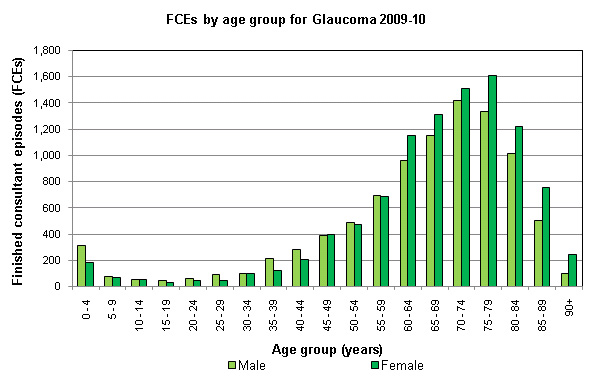IN THIS SITE...

- NHS Choices: Glaucoma
- International Glaucoma Association
- Inpatient data
- Self Service
HES on... Glaucoma
According to NHS Choices, in England, about 480,000 people have chronic open-angle glaucoma. Among white Europeans, about 1 in 50 people above 40 years old and 1 in 10 people above 75 years old has chronic open-angle glaucoma. It may be more common among people of black-African or black-Caribbean origins.
The other types of glaucoma are much less common. Among white people, acute angle-closure glaucoma may affect about 1 in 1,000 people. It is more common among people of Asian origin, affecting around 1 in 100 of them. This article gives an overview of the condition and highlights related 2009-10 HES data.
What is glaucoma?
Glaucoma is the name for a group of eye diseases where the patient's optic nerve is damaged and vision is affected. The following types of glaucoma make up the group:
- open angle glaucoma (H40.1 in ICD-10), where there is a gradual increase in internal eye pressure and worsening of vision over several years
- closed angle glaucoma (H40.2 in ICD-10), where there is a sudden increase in internal eye pressure, often needing immediate treatment in hospital
- secondary glaucoma (H40.3 to H40.5 in ICD-10), where increases in internal eye pressure which is a result of another eye condition
- glaucoma secondary to drugs (H40.6 in ICD-10)
- other glaucoma (H40.8 in ICD-10)
- glaucoma, unspecified (H40.9 in ICD-10)
- congenital glaucoma (Q15.0 in ICD-10), where increases in internal eye pressure are due to a physical abnormality of the eye at birth.
If glaucoma is left untreated, the loss of vision usually gets worse and, in some cases, can result in blindness.
Who does it affect?
Hospital Episodes Statistics (HES) data shows that in 2009-10 (in England), 60- to 84-year-olds (69.9%) are most likely to be treated in hospital for the condition (see graph below).
 |
HES facts and figures
HES data for glaucoma (diagnosis codes H40 (all) and Q15.0 in ICD-10) show that:
- most hospital admissions for glaucoma are from waiting lists rather than through emergency admissions (16,458 admissions from waiting lists compared to 1,421 emergency admissions)
- the most common procedures carried out on patients were:
- filtering operation on iris (C60 in OPCS 4.5), representing 5,680 (29.0%) FCEs
- incision of iris (C62 in OPCS 4.5), representing 3,608 (18.4%) FCEs
- extirpation of ciliary body (C66 in OPCS 4.5), representing 2,077 (10.6%) FCEs.
- Glaucoma was responsible for 19,572 episodes of admitted patient care, accounting for 5,996 FCE bed days.
More information on this topic is available from NHS Choices here.

